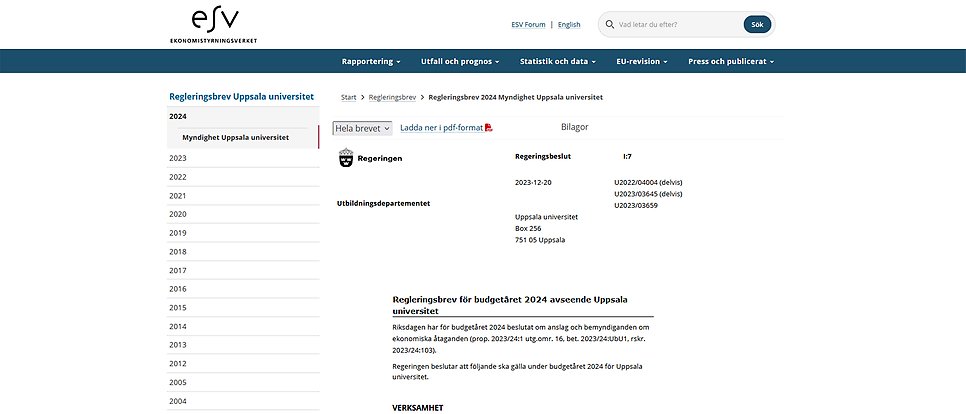How does the State govern the University?

The government’s annual appropriation directions govern the University’s activities. The government issues appropriation directions for each authority every year after the Riksdag has adopted the national budget. Photo: Screenshot.
The national budget and instructions to higher education institutions follow a process that recurs every year and features a number of key concepts. Of course there is no need to know all the ins and outs of this process, but a general overview can be helpful to better understand the University’s place in the state machinery.
This article begins by outlining what happens over the course of a year and then goes on to describe the different stages in a little more detail.
Every fourth year, the Riksdag (the Swedish parliament) adopts a research and innovation bill proposed by the government. This is a long-term plan for research and innovation that defines the direction of budget bills for the next few years.
Every year the University Board makes a budget submission ahead of the government’s work on the budget bill.
The Riksdag adopts the national budget based on the government’s budget bill. The bill is the government’s proposal for the national budget and contains both appropriations and instructions for the next calendar year.
After the Riksdag has adopted the national budget, the government decides on appropriation directions for all authorities.
The next step is for the University Board to adopt an operational plan for all of Uppsala University, based on the appropriation directions. This in turn is broken down into numerous operational plans for different parts of the University.
Overall regulation
The Higher Education Act and Higher Education Ordinance regulate universities and other higher education institutions at a general level. In addition, the Government Agencies Ordinance provides regulations that apply to all state authorities. The Act and Ordinance define duties and responsibilities in a general and long-term way. They apply from year to year but are amended when necessary.
Research and innovation bill
The research and innovation bill is the government’s long-term proposal for research and innovation. Like all government bills, it has to be approved by the Riksdag to take effect. The bill normally covers a four-year period and indicates a direction for research and innovation in the next few years’ budget bills.
A new government bill on research and innovation is expected in autumn 2024. Ahead of the government’s work on the bill, the higher education institutions have been invited to submit input to the government.
Budget submission
Each year, the University Board decides on a budget submission covering the next three years. The budget submission is sent to the government in February as input for the government’s work on the budget bill.
Budget bill
The government presents its annual budget bill in September. This bill is the government’s proposal for the national budget for the next year. The budget bill covers a three-year period but the decision on funding only applies for one year. The budget bill contains proposals on the instructions and budgets for state authorities. The instructions are often new, and there are often changes in the allocation of funding. All issues that have an impact on the budget are included in the budget bill.
The government’s budget bill is processed by the Riksdag during the autumn. It is the Riksdag that adopts the national budget.
Appropriation directions
After the Riksdag has adopted the national budget, the government decides on appropriation directions for all state authorities. Appropriation directions are formal decisions by the government on instructions and funding for the next year and are issued every year.
The appropriation directions describe how the authority is to work and how much money the authority can use. The appropriation directions often contain targets, reporting requirements and instructions for the next financial year.
The government itself can decide on instructions that do not have an impact on the budget and any such instructions are also included in the appropriation directions. Any instructions that affect the budget have to be approved by the Riksdag via the budget bill (see above).
Note that it is the government as a collective body that governs the state authorities. The fact that this is done by collective decision of the government is an important point. Individual ministers cannot decide what an authority is to do on their own. That would be called ministerial rule and it is not permitted in Sweden.
It is not just the University’s own appropriation directions that affect Uppsala University; the appropriation directions for the universities and other higher education institutions are also relevant, as are the appropriation directions for other authorities that influence the University’s activities in one way or another.
Operational plan
Based on the national budget and appropriation directions, the University Board adopts the operational plan for the University. The operational plan is for a three-year period, but the decision on allocation of funds is only for the next year.
The operational plan divides up the University’s direct government funding between the University’s various activities. Some activities at the University will already have received earmarked government funding and instructions in the national budget and appropriation directions.
Based on the University’s overall operational plan, operational plans are then drawn up for the disciplinary domains, faculties, departments and University Administration.
Other legislation
The governance of a higher education institution is naturally also affected by various other primary and secondary legislation – laws and ordinances that in one way or another govern how activities are conducted at a higher education institution.
Anders Berndt
Read more
Budget submission, information on the Staff Gateway (not available in English)
Uppsala University’s input to the government’s research and innovation policy bill
Research and innovation bill, Government Offices website (not avaible in English
The budget bill, Government Offices website (not availble in English
